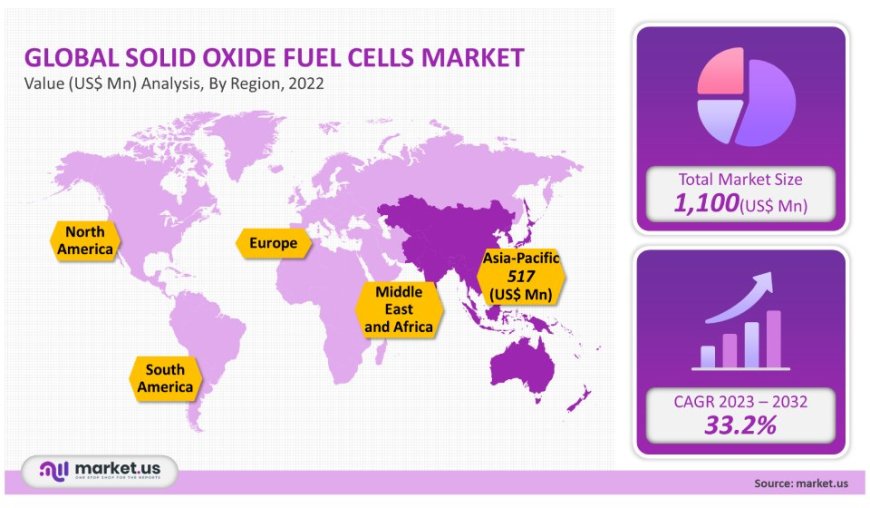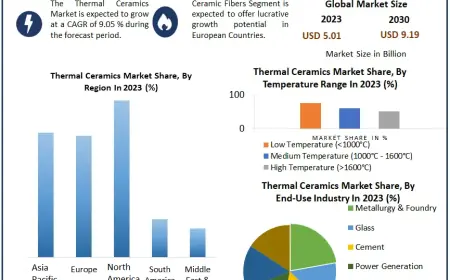Solid Oxide Fuel Cell Market 2023 Industrial Trends, Consumption Volume, Key Tactics and Competitive Strategies by 2032
In 2021, the global solid oxide fuel cells market was valued at US$ 1,100 million and projected to experience compound annual compound rate growth between 2023-2032 at an estimated compound annual compound annual rate (CAGR) of 33.28%.

Market Overview
The Solid Oxide Fuel Cell Market (SOFC) is projected to experience rapid expansion, driven by their superior energy efficiency, fuel versatility, and emissions reduction properties. SOFCs offer numerous applications spanning distributed generation, stationary power generation, transportation and more.
In 2021, the global solid oxide fuel cells market was valued at US$ 1,100 million and projected to experience compound annual compound rate growth between 2023-2032 at an estimated compound annual compound annual rate (CAGR) of 33.28%.
Solid Oxide Fuel Cell Market Dynamics:
Drivers:
- Rising Demand for Clean Energy: SOFCs provide an extremely efficient and green way of producing electricity with few greenhouse gas emissions and other pollutants released into the atmosphere, making them an attractive option for countries and businesses looking to lower their environmental impact.
- Government Support: Governments around the world are providing financial and other forms of assistance for SOFC development and deployment, which has significantly reduced system costs while making SOFC systems more cost-competitive with other forms of power generation.
- Technological Advancements: SOFC technology is continually progressing with new materials and designs being released that improve efficiency, durability and cost-effectiveness of SOFCs - making them more suitable for a wider variety of applications.
- An expanding product variety: SOFC systems have now become more versatile, from residential units to large-scale power plants - making SOFCs suitable for more applications than ever before.
Free PDF Sample of our In-Depth Report: https://market.us/report/solid-oxide-fuel-cells-market/request-sample/
Restraints:
- High cost: Solid oxide fuel cells (SOFCs) currently cost more to produce than alkaline fuel cells due to the higher cost of their materials, including yttria-stabilized zirconia (YSZ) and lanthanum strontium manganite (LSM). This may change as production costs come down further.
- Lack of Infrastructure: Due to infrastructural inadequacies for producing, distributing and storing hydrogen for SOFC use, accessing hydrogen is both difficult and expensive.
- Technical Challenges: SOFCs operate at high temperatures, which can lead to material degradation and other technical problems. Researchers and manufacturers are actively attempting to resolve these challenges; however, none have yet been resolved completely.
- Technical Challenges: SOFCs face technical obstacles such as material degradation that hamper their adoption. In order to fully commercialize SOFCs, these challenges must first be overcome before being commercialized at scale.
Opportunities:
- Clean energy generation: has become more critical as governments and businesses seek ways to lower their carbon emissions. SOFCs provide an environmentally-friendly energy solution, making them increasingly attractive options as governments and businesses work towards mitigating carbon footprints.
- Fuel flexibility: SOFC have become an important way of producing electricity as governments and businesses around the world look for ways to lower their carbon emissions.
- Technological Advancements: SOFC technology continues to advance, with each new development leading to greater efficiency, durability, and affordability.
- Utility-Scale Power Generation: SOFCs are ideal for utility-scale power generation because of their continuous operation at high efficiency, making them an excellent solution for baseload power plants that help lower greenhouse gas emissions from the electricity sector.
Challenges:
- An Excessive Cost: SOFCs currently tend to be more costly than other forms of fuel cells such as proton exchange membrane fuel cells (PEMFCs), due to their complex manufacturing process and use of expensive materials.
- Carbon Dusting: Carbon dusting occurs in SOFCs when carbon from fuel reacts with nickel-yttria-stabilized zirconia (YSZ) electrolyte to form carbon deposits that clog oxygen ions, hindering performance and durability of SOFCs.
- Lack of Infrastructure: Due to limited production, storage, and distribution facilities for hydrogen used as the primary fuel in SOFCs, their deployment may be restricted in certain applications.
- Competition from Other Technologies: SOFCs are competing with other clean energy technologies such as solar and wind power, in addition to competing against different types of fuel cells like PEMFCs.
Key Market Segments:
By Type
- Tubular
- Planar
- Other Types
By Application
- Transportation
- Portable
- Stationary
Маrkеt Кеу Рlауеrѕ:
- Bloom Energy
- Mitsubishi Power Ltd.
- Cummins Inc.
- Ceres
- General Electric
- Fuel Cell Energy Inc.
- Ningbo SOFCMAN Energy
- KYOCERA Corporation
- AVL
- NGK SPARK PLUG CO., LTD.
- Other Key Players
Contact us
Global Business Development Team: Market.us
Market.us (Powered By Prudor Pvt. Ltd.)
Send Email: inquiry@market.us
Address: 420 Lexington Avenue, Suite 300 New York City, NY 10170, United States
Tel: +1 718 618 4351, +91 78878 22626
What's Your Reaction?
 Like
0
Like
0
 Dislike
0
Dislike
0
 Love
0
Love
0
 Funny
0
Funny
0
 Angry
0
Angry
0
 Sad
0
Sad
0
 Wow
0
Wow
0














































